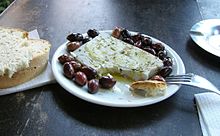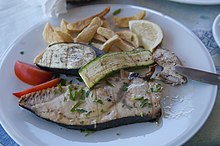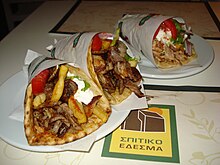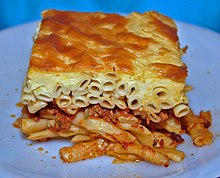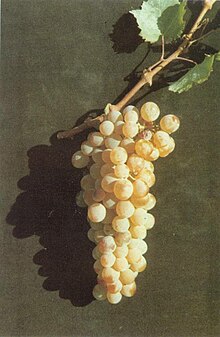Greek cuisine is very diverse and although there are many common characteristics amongst the culinary traditions of different regions within the country, there are also many differences, making it difficult to present a full list of representative dishes. For example, the vegetarian dish "Chaniotiko Boureki" (oven baked slices of potatoes with zucchini, myzithra cheese and mint) is a typical dish in western Crete, in the region of Chania. A family in Chania may consume this dish 1-2 times per week in the summer season. However, it is not cooked in any other region of Greece. Many food items are wrapped in Filo pastry, either in bite-size triangles or in large sheets: kotopita (chicken), spanakotyropita (spinach and cheese), chortopita (greens), kreatopita (meat pie, using minced meat), etc.
The list will present some of the most representative Greek dishes that can be found throughout the country and the most famous of the local ones:
Breads
- Daktyla
- Eliopsomo, bread with olives
- Paximadi, Cretan bread
- Karydopsomo, bread with walnuts
- Lagana
- Pita
- Stafidopsomo, bread with raisin
Appetizers and Salads
Meze or orektiko (appetizer; plural mezedes/orektika) is served in restaurants called mezedopoleía, served to complement drinks, and in similar establishments known as tsipourádika or ouzerí (a type of café that serves drinks such as ouzo or tsipouro). A tavérna (tavern) or estiatório(restaurant) also offers a meze as an orektikó (appetiser). Many restaurants offer their house pikilía (variety) a platter with a smorgasbord of various mezedes that can be served immediately to customers looking for a quick or light meal. Hosts commonly serve mezedes to their guests at informal or impromptu get-togethers as they are easy to prepare on short notice. Krasomezédhes (literally "wine-meze") are mezedes that go well with wine;ouzomezédhes are mezedes that go with ouzo.
- Bakaliaros, Bacalhau
- Deep-fried vegetables "tiganita" (courgettes/zucchini, aubergines, peppers, or mushrooms).
- Dakos, a Cretan salad consisting of a slice of soaked dried bread or barley rusk (paximadi) topped with chopped tomatoes and crumbled feta or mizithra cheese.
- Dolmadakia (from Turkish dolma): grapevine leaves stuffed with rice and vegetables; meat is also often included.
- Fava: purée of yellow split peas or beans; sometimes made of fava beans (called κουκιά in Greek). In Santorini made from yellow lentils.
- Garides Saganaki: shrimp in spicy tomato sauce with feta cheese.
- Gavros: european anchovy.
- Greek salad: the so-called Greek salad is known in Greece as village/country salad (horiatiki) and is essentially a tomato salad with cucumber, red onion, feta cheese, and kalamata olives, dressed with olive oil. In Cyprus it contains also cracked wheat (bulgur), spring onions instead of red onions, and lemon juice.
- Horta: wild or cultivated greens, steamed or blanched and made into salad, simply dressed with lemon juice and olive oil. They can be eaten as a light meal with potatoes (especially during Lent, in lieu of fish or meat).
- Kalamarakia: deep-fried squid.
- Kalamata olives
- Kalitsounia, appetizer from Crete
- Kaparosalata (salad with caper)
- Katsouni, cucumber from Santorini
- Kolokythakia: zucchini.
- Kolokythoanthoi: zucchini flowers stuffed with rice or cheese and herbs.
- Koukia: fava beans.
- Kroketes: croquettes.
- Lachanosalata: cabbage salad. Very finely shredded cabbage with salt, olive oil, lemon juice/vinegar dressing. Often combined with finely shredded carrot.
- Lakerda, a pickled bonito dish
- Macedonia salad
- Maintanosalata (salad with parsley)
- Marides tiganites: deep-fried whitebait, usually served with lemon wedges.
- Melitzanes, eggplants. Notable is the white eggplant from Santorini.
- Melitzanosalata: eggplant (aubergine) based dip.
- Pantzarosalata: beetroot salad with olive oil and vinegar.
- Patatosalata: potato salad with olive oil, finely sliced onions, mayonnaise, lemon juice or vinegar.
- Red Peppers of Florina
- Saganaki: fried yellow cheese, usually graviera cheese; the word "saganaki" means a small cooking pan, is used to say "fried" and can be applied to many other foods.
- Skordalia: thick garlic and potato puree, usually accompanies deep fried fish/cod (bakaliaros skordalia, i.e. fried battered cod with garlic dip, a very popular dish).
- Spanakopita: spinach, feta (sometimes in combination with ricotta cheese), onions or scallions, egg and seasoning wrapped in phyllo pastry in a form of a pie.
- Taramosalata: fish roe mixed with boiled potatoes or moistened breadcrumbs, olive oil and lemon juice.
- Tirokafteri, cheese spread.
- Tonosalata, tuna salad
- Tzatziki: yogurt with cucumber and garlic puree, used as a dip. Served with warm pita bread. (Turkish equivalent : Cacık)
- Tyropita: a white cheese (usually feta) pie with phyllo pastry. When yellow cheese (usually kasseri) is used, it is called Kasseropita.
Also, several pitas found all over Greece, such as Kolokythopita, Mizithropita (Crete), Melintzanopita, Tsouknidopita, Kremydopita, Kreatopita (meat pie), Galatopita, Marathopita, Malathropita (Chios), Ladopita.
Soups
- Kotosoupa Avgolemono, chicken and rice soup with egg lemon sauce added
- Bourou-bourou, a vegetable and pasta soup from the island of Corfu
- Fakes, a lentil soup, usually served with vinegar and olive oil.
- Fasolada, a white-bean soup defined in many cookery books as the traditional Greek dish, sometimes even called "the national food of the Greeks".[13] It is made of beans, tomatoes, carrot and a generous amount of celery usually served with a variety of salty side dishes(like olives or anchovies).
- Kakavia, soup made from any variety of small local fish with the bones removed before serving
- Kremydosoupa, onion soup served with vinegar.
- Magiritsa, the traditional Easter soup made with lamb offal, lamb liver, lamb lung and sometimes mutton meat usually thickened with avgolemono.
- Patsas, a tripe soup.
- Psarosoupa 'fish soup' can be made with a variety of fish (usually kokkinopsaro) and several kinds of vegetables (carrots, parsley, celery, potatoes, onion), several varieties include the classic kakavia which is drizzled with olive oil.
- Revithia, a chickpea soup.
- Trahana soup, made from a dried grain-dairy substance and chicken fat.
Vegetarian main dishes
Very popular during fasting periods, such as the Great Lent:
- Anginares a la Polita:artichokes Constantinople style with artichoke hearts, olive oil, potatoes, carrots dill.
- Arakas me anginares: oven-baked fresh peas with artichokes.
- Bamies: okra with tomato sauce (sometimes with potatoes or during non-fasting times with chicken/lamb).
- Briám: an oven-baked ratatouille of summer vegetables based on sliced potatoes and zucchini in olive oil. Usually includes eggplant, tomatoes, onions, and ample aromatic herbs and seasonings.
- Fasolakia: fresh green beans stewed with potatoes, zucchini and tomato sauce.
- Gemista, baked stuffed vegetables. Usually tomatoes, peppers, or other vegetables hollowed out and baked with a rice-and-herb filling or minced meat.
- Gigandes plaki: large lima beans baked with tomato sauce and various herbs.[14] Often made spicy with various peppers.
- Horta (greens), already mentioned in the appetizers section, are quite often consumed as a light main meal, with boiled potatoes and bread.
- Kinteata, dish made from boiled young nettles.
- Lachanorizo, cabbage with rice.
- Prassorizo, leeks with rice.
- Spanakorizo, spinach and rice stew cooked in lemon and olive-oil sauce.
- Tomatokeftedes: tomato fritters with mint, fried in olive oil and typically served with fava (split-pea puree). Mainly a Cycladic island dish.
Meat and seafood dishes
- Apáki: Cretan specialty; lean pork marinated in vinegar, then smoked with aromatic herbs and shrubs, and packed in salt.
- Astakos: lobster.
- Astakomacaronada: spaghetti with lobster.
- Atherina: fried smelts.
- Barbounia: red mullets.
- Bifteki: Ground beef burgers either baked, fried or grilled.
- Bourdeto: from Corfu.
- Chtapodi sti schara: grilled octopus in vinegar, oil and oregano. Accompanied by ouzo.
- Giouvetsi: lamb or veal baked in a clay pot with kritharaki (orzo) and tomatoes.
- Glossa, Solea (genus)
- Gyros: meat (usually pork) roasted on a vertically turning spit and served with sauce (often tzatziki) and garnishes (tomato, onions) on pita bread, or served as a sandwich wrapped in pita bread together with tomatoes, onions, tzatziki and tomato sauce; a popular fast food.
- Kalamari: squid, most often fried.
- Kleftiko: literally meaning "in the style of the Klephts", this is lamb slow-baked on the bone, first marinated in garlic and lemon juice, originally cooked in a pit oven. It is said that the Klephts, bandits of the countryside who did not have flocks of their own, would steal lambs or goats and cook the meat in a sealed pit to avoid the smoke being seen.
- Keftedakia, fried meatballs.
- Kokkinisto, stew.
- Loukaniko, sausage
- Moussaka (from Arabic مسقعة musaqqa'): an oven-baked layer dish: ground meat and eggplant casserole, topped with a savory custard which is then browned in the oven. There are other variations besides eggplant, such as zucchini or rice, but the eggplant version, melitzánes moussaká is by far the most popular. The papoutsákia ("little shoes") variant is essentially the same dish, with the meat and custard layered inside hollowed, sauteéd eggplants.
- Mydia: mussels.
- Oven-baked lamb with potatoes (Αρνί στο φούρνο με πατάτες). One of the most common "Sunday" dishes. There are many variations with additional ingredients.
- Oven-baked chicken with potatoes (Κοτόπουλο στο φούρνο με πατάτες). Another common Sunday dish.
- Paidakia: grilled lamb chops with lemon, oregano, salt and pepper.
- Pastitsada
- Pastitsio: an oven-baked layer dish: Béchamel sauce top, then pasta in the middle and ground meat cooked with tomato sauce at the bottom.
- Pork with celery (hirino me selino/hirino selinato).
- Savridia: mackerels oven-baked or fried.
- Sheftalia
- Sofrito, from Corfu
- Soupia: cuttlefish
- Soutzoukakia Smyrneika (Smyrna meatballs): long shaped meatballs with cumin, cinnamon and garlic and boiled in tomato sauce with whole olives. Often served with rice or mashed potatoes.
- Souvlaki: (lit: "skewer") grilled small pieces of meat (usually pork but also chicken or lamb) served on the skewer for eating out of hand, or served as a sandwich wrapped in pita bread together with tomatoes, onions, tzatziki and tomato sauce; a popular fast food, also called kalamaki (small reed) mainly in Athens.
- Spetsofai: a stew of country sausage, green mild peppers, onions and wine. Originates from Pelion.
- Stifado: rabbit or hare stew with pearl onions, vinegar, red wine and cinnamon. Beef can be substituted for game.
- Xiphias: swordfish.
- Yiouvarlakia: meatballs soup with egg-lemon sauce.
Quick meals
Meals easily available with inexpensive ingredients and little preparation involved.
- Hilopites pasta with chicken: savory chicken is mixed with "Hilopites" or cut up tile-shaped pasta in a spiced tomato sauce.[15]
- Macaronada: classic spaghetti.
- Manestra
- Omeletta
- Strapatsada: eggs scrambled in olive oil and fresh tomato puree, seasoned with salt, pepper and oregano. Often includes feta cheese.
Desserts and sweets
- Amygdalopita: pie with almonds
- Amygdalotá or pastéli exist in many varieties throughout Greece and Cyprus, and are especially popular in the islands. They consist of powdered blanched almonds, confectioner's sugar and rose water, molded in various shapes and sizes. They are snow-white and are considered wedding and baptismal desserts.
- Copenhagen (dessert)
- Baklava, phyllo pastry layers filled with nuts and drenched in honey.
- Diples, a Christmas and wedding delicacy, made of paper-thin, sheet-like dough which is cut in large squares and dipped in a swirling fashion in a pot of hot olive oil for a few seconds. As the dough fries, it stiffens into a helical tube; it is then removed immediately and sprinkled with honey and crushed walnuts.[16]
- Finikia, cookie topped with chopped nuts.
- Galaktoboureko, custard baked between layers of phyllo, and then soaked with lemon-scented honey syrup. The name derives from the Greek "gala"(γάλα), meaning milk, and from the Turkish börek, meaning filled, thus meaning "filled with milk".
- Halva
- Karydopita, a cake of crushed walnuts, soaked or not in syrup.
- Koulourakia, butter or olive-oil cookies.
- Kourabiedes, Christmas cookies made by kneading flour, butter and crushed roasted almonds, then generously dusted with powdered sugar. (equivalent in Turkey: Kurabiye - possibly originated from Persia in 7th century "Qurabiya")
- Lazarakia
- Loukoumades, similar to small crusty donuts, loukoumades are essentially fried balls of dough drenched in honey and sprinkled with cinnamon, typically served with sesame seed.
- Loukoumi is a confection made from starch and sugar, known in English as Turkish Delight. Patrina loukoumia are famously produced in the city ofPatras. A variation from Serres is called Akanés. Loukoúmia are flavored with various fruit flavors, with rose water considered the most prized.
- Mandola, from Corfu
- Mandolato
- Melitinia cookies, from Santorini
- Melopita, honey pie
- Melomakarona, "honey macaroons", Christmas cookies soaked with a syrup of diluted honey (méli in Greek) and then sprinkled with crushed walnuts.
- Milopita, apple pie with cinnamon and powdered sugar.
- Moustalevria, a flour and grape must flan.
- Moustokouloura, cookies of flour kneaded with fresh grape juice (must) instead of water.
- Pasta flora (Πάστα Φλώρα), jam-filled tart with lattice
- Pasteli
- Rizogalo ("rice-milk") is rice pudding.
- Roxakia, syrupy vanilla-cocoa cookies
- Spoon sweets (γλυκά του κουταλιού) of various fruits, ripe or unripe, or green unripe nuts. Spoon sweets are essentially marmalade except that the fruit are boiled whole or in large chunks covered in the fruit's made syrup.
- Trigona, from Thessaloniki
- Tsoureki, a traditional Christmas and Easter sweet bread also known as 'Lambropsomo' (Easter bread), flavored with "mahlepi", the intensely aromatic extract of the stone of the St. Lucie Cherry.
- Vasilopita, Saint Basil's cake or King's cake, traditional only for New Year's Day. Vasilopites are baked with a coin inside, and whoever gets the coin in their slice are considered blessed with good luck for the whole year.
- Yogurt with honey and walnuts.
Cheeses
There is a wide variety of cheeses made in various regions across Greece. The vast majority of them remain unknown outside the Greek borders due to the lack of knowledge and the highly localized distinctive features. Many artisanal, hand made cheeses, both common varieties and local specialties, are produced by small family farms throughout Greece and offer distinct flavors atypical of the mass-produced varieties found commercially in Greece and abroad. A good list of some of the varieties of cheese produced and consumed in Greece can be found here. These are some of the more popular throughout Greece:
Non-alcoholic beverages
There is a variety of non alcoholic beverages that are drunk in Greece even to this day.
Portokalada (orangeade) and Lemonada (lemonade), since 1971, these beverages were served everywhere, in homes, cafes, tavernas and restaurants. They were made with fresh strained orange juice or lemon juice either mixed with carbonated water or flat mineral water and you added sugar to taste. There were also bottled local versions. In 1989 on the island of Rhodes there were 2 companies that made and bottled their own portokalada and lemonada using local oranges, lemons and water. These beverages are still standards today, as of 2014, the difference being that most of the small local companies sold their businesses to the big companies like Fanta etc., thus, greatly changing the quality.
Visinada (cherryade) is made from dark cherry syrup (which was originally homemade) mixed with cold water.
Coffee
The traditional coffeehouses in Greece are called kafenia, and they offer coffee, refreshments, alcoholic beverages and snacks or meze. In recent years, especially in the large urban centres, kafenia are gradually being replaced by modern "cafeterias". Preferred types of coffee are, among others, Turkish coffee (locally known as "Greek coffee"), frappé (a foam-covered iced coffee drink), and iced cappuccino and espresso, named Freddo Cappuccino and Freddo Espresso, respectively.[17] Iced coffee-based drinks, such as freddoccino or freddito, are also popular in the summer.
Tea and herbal teas
- Chamomile- (chamomile tea)
- Mint tea- right out of the garden
- Faskomilo- (sage tea) tea made from dried or fresh sage
- Tsai vounou- tea from steeped mountain sage. To this day the Greeks still like to drink a tea made from steeping dried or fresh mountain sage
- Sideritis
Alcoholic beverages
Wine
For more details on this topic, see Greek wine.
The origins of wine-making in Greece go back 6,500 years[18][19] and evidence suggesting wine production confirm that Greece is home to the oldest known grape wine remnants discovered in the world[20] and the world’s earliest evidence of crushed grapes.[18] The spread of Greek civilization and their worship of Dionysus, the god of wine, spread Dionysian cults throughout the Mediterranean areas during the period of 1600 BC to the year 1 AD.[21] Greece's viticultural history goes back to prehistoric times,i[›] and wine production was thriving until the 11th century.[22] After World War II, Greek winemakers imported and cultivated foreign grape varieties, especially French ones, in order to support local production.[23] In 1960s, retsina, a drywhite wine with lumps of resin, was probably the most well-known Greek wine abroad. In recent years, local varieties are rediscovered and often blended with foreign ones.[24] In early 1980s, a system of appellations, modelled on the respective French one, was implemented to assure consumers the origins of their wine purchases. Today, there are 28 appellations (Appellations of Origin of Superior Quality and Controlled Appellation of Origin) throughout the country, from Macedonia to Crete.[25]
Beer
Archaeological and archaeochemical finds suggest that the Minoans fermented barley and other substances, and consumed some form of beer.[26]The beer tradition of the Minoans was discontinued by the Mycenaeans; beverages from fermented cereals may have remained only in Crete during their rule.[27] In Archaic and Classical Greece, beer is mentioned as a foreign beverage, while, when Alexander the Great conquered in 332 BC Egypt, a civilization with a long brewing tradition, the Greeks continued to disdain beer seeing it as the drink of their rivals.[28] In Modern Greece, a limited number of brands — owned by breweries from northern Europe in most cases (e.g. Heineken or Amstel) — dominated for many years the local market, while a stringent Bavarian-influenced beer purity law was in force.[29] Gradually, the provisions of this law loosened, and, since the late 1990s, new local brands emerged (in 1997 Mythos made a breakthrough) or re-emerged (e.g. Fix Hellas), reviving competition. In recent years, in parallel with the large breweries, local microbreweries operate throughout Greece.[30]




